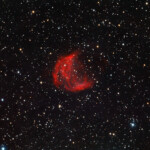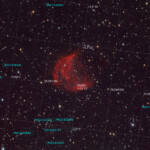The Medusa Nebula is a planetary nebula in the constellation of Gemini. It is also known as Abell 21 and Sharpless 2-274. It was originally discovered in 1955 by University of California, Los Angeles astronomer George O. Abell, who classified it as an old planetary nebula. Until the early 1970s, the nebula was thought to be a supernova remnant. With the computation of expansion velocities and the thermal character of the radio emission, Soviet astronomers in 1971 concluded that it was most likely a planetary nebula. As the nebula is so large, its surface brightness is very low, with surface magnitudes of between +15.99 and +25 reported.

Abell 21, Medusa Nebula
The Medusa Nebula is a planetary nebula in the constellation of Gemini. It is also known as Abell 21 and Sharpless 2-274. It was originally discovered in 1955 by University of California, Los Angeles astronomer George O. Abell, who classified it as an old planetary nebula. Until the early 1970s, the nebula was thought to be a supernova remnant. With the computation of expansion velocities and the thermal character of the radio emission, Soviet astronomers in 1971 concluded that it was most likely a planetary nebula. As the nebula is so large, its surface brightness is very low, with surface magnitudes of between +15.99 and +25 reported.
Photographed with MN 190 reflector telescope and Atik 360EX CCD camera in Åva, March 2021. Exposure was 20 min RGB each, L 20 min, and Ha 30 min a failrly windy night.

Abell 21, Medusa Nebula
The Medusa Nebula is a planetary nebula in the constellation of Gemini. It is also known as Abell 21 and Sharpless 2-274. It was originally discovered in 1955 by University of California, Los Angeles astronomer George O. Abell, who classified it as an old planetary nebula. Until the early 1970s, the nebula was thought to be a supernova remnant. With the computation of expansion velocities and the thermal character of the radio emission, Soviet astronomers in 1971 concluded that it was most likely a planetary nebula. As the nebula is so large, its surface brightness is very low, with surface magnitudes of between +15.99 and +25 reported.
Photographed with MN 190 reflector telescope and Atik 360EX CCD camera in Åva, March 2021. Exposure was 20 min RGB each, L 20 min, and Ha 30 min a failrly windy night.